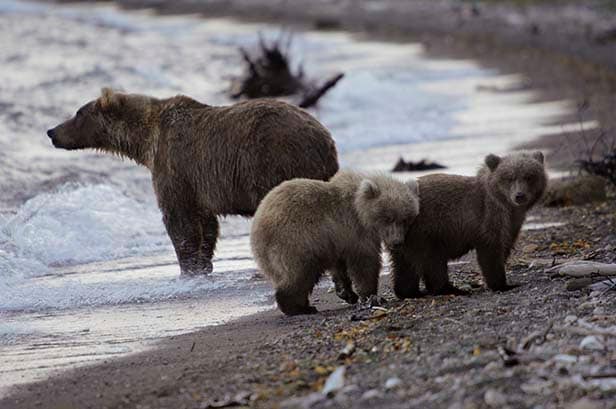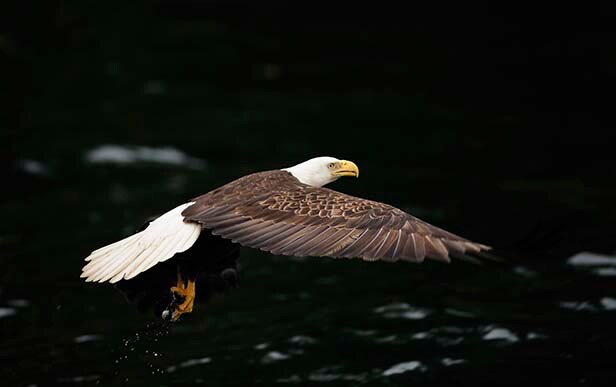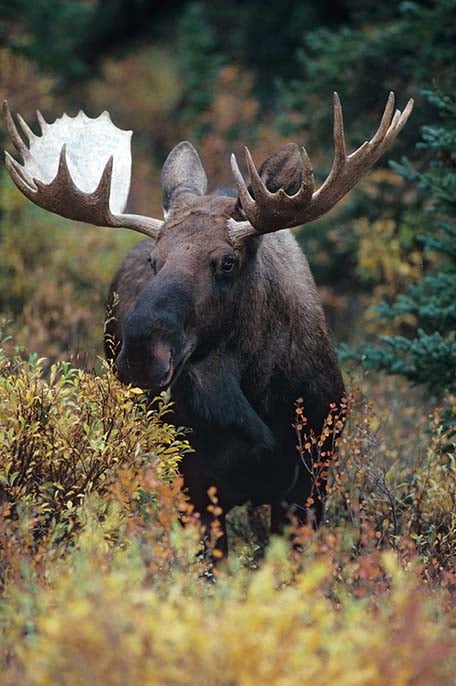Alaska’s wildlife is unpredictable, captivating and raw, filled with hundreds of species, ranging from determined salmon swimming up the rivers to spawn to the magnificent grizzlies roaming the untamed terrain in search of their next meal.

The dream of observing wildlife in its natural habitat is what lures many visitors to Alaska. In a state that’s bigger than Texas, California and Montana combined, every moment is an opportunity to see rare animals in their natural environment. Training your eyes to properly spot wildlife means knowing not just where to look, but how to tell the difference between the wild landscape and the wild animals.
Soaring Through the Sky

Bald eagles, the national bird of the United States, are far more abundant in Alaska than anywhere else in the country. With a gigantic wingspan of up to 7 feet and distinctive white heads, it’s nearly impossible to cruise to Alaska and not see at least one. Watch for the white “snowball” of the eagles’ head in the tops of the trees. Once you learn to spot them, you tend to recognize these magnificent birds of prey everywhere.
“During the peak of salmon spawning season, bald eagles feed in droves of sometimes 50 or more out over the inlets,” says Michele Morris, one of Carnival’s onboard naturalists. Morris started with Carnival on their first Alaskan cruise back in 1996, and if she’s not on board, you can be sure to find one of the other naturalists to answer any wildlife questions you may have.
Bear Spotting
Bears, both brown and black, are typically solitary animals. Grizzly bears, the mainland subspecies of brown bears, are much larger than their black bear cousins, weighing between 500 – 900 pounds and having a more prominent hump on their shoulder. Black bears, despite their name, can range in color from a sandy blond to an almost bluish shade of gray and weigh between 200 – 500 pounds.
Black bears tend to live in dense forests, and there are a total of 100,000 black bears throughout the state. Grizzly bears typically live along Alaska’s southern coast, where they primarily feed on salmon. According to the Alaska Department of Fish and Game, there can be as many as one grizzly bear per square mile in portions of southern Alaska, especially in areas with plentiful food sources.
Spotting bears is easier than you think. When you’re out on the ocean, look along the shoreline for shiny black rocks that stand out against the typical dull black rocks. Once you spot one, watch for any signs of movement. Typical boulders will appear dull, but a bear’s fur looks particularly oily, and that distinct sheen will stand out against the landscape. Once the salmon begin to swarm the rivers in late July through early September, many bears will move to the streams to feed.
Just keep in mind that bears are best when seen from a distance. If you are hiking in bear territory, especially along a river teeming with salmon, make your presence known. “If you do come across a bear, stand your ground, wave your arms in the air and speak loudly,” says Dan Irelan, Park Ranger for Denali National Park & Preserve. “I had a bear approach me as I was walking along a river. I stood my ground and eventually the big momma bear and her curious cubs turned around, leaving me with a racing heart and a good story to tell.”
Moose

It’s a deer. It’s a horse. No, it’s a giant moose! Unlike many of Alaska’s wildlife, these iconic creatures don’t stick to the wilderness. Moose seem to appear when you least expect them, whether prancing through the parking lot as you’re hopping on a tour bus or simply standing in a small pond by the side of the road, sipping the cool water as cars pass by.
Alaska has anywhere from 175,000 to 200,000 of these long-legged mammals. They’re frequently seen in areas that have been recently affected by forest fires and along the major rivers of Southcentral and Interior Alaska.
Their sheer size is hard to appreciate from a distance. A bull (male) moose stands 7 feet tall at the shoulder and can weigh up to 1,600 pounds. If that’s not massive enough, the bulls can also grow an 80-pound antler rack in a single summer. That’s about one pound of bone growth a day. It’s quite impressive to see how gracefully they move throughout the forest, despite all that additional weight.
Caribou
Caribou are one of the most recognized symbols of the great wild north. Much smaller than moose, caribou weigh between 175 – 400 pounds. They have the distinction of being the only member of the deer family whose males and females both grow antlers. They spend most of their time in the open country and have adapted to the cold, wind and snow of even the harshest Alaskan winters.
Caribou are difficult to spot even for wildlife peeping pros, but it’s possible with a keen eye and a little patience. In the summer, caribou spend most of their time in the remaining snow patches high on the mountains. Keep your binoculars handy while scanning the spines of the mountains. Allow your eyes to adjust and look for out-of-place silhouettes. You just might get a peek of the elusive caribou.
Mountain Goats and Dall Sheep
Agility and strength are a necessity for these all-white mountaineering ungulates (hooved animals) as they spend most of their time clambering through steep and rocky terrains. Dall sheep and mountain goats look similar, but one look at their horns and you’ll know which is which: Dall sheep have ram-shaped horns that curve on the side of their head, while mountain goats flaunt pointed horns. Though they have comparable body shapes, Dall sheep can weigh up to 300 pounds. Mountain goats weigh up to 380 pounds and often seem much bigger due to their long fur and fluffy beards.
Peeping either of these two bovids will require a lot of neck bending, because these rugged climbers are high country dwellers. Dall sheep roam throughout every mountain range in Alaska. They tend to huddle in dry habitats in open alpine ridges, meadows and steep slopes. Mountain goats, on the other hand, are most frequently found in the southeast, where they feed low in the early summer and move higher as the snow melts. If Juneau is one of your ports of call, you’re in luck. Mountain goats were actually reintroduced to Mount Juneau in 1989 and have become a common sight since the early 2000s.
From afar, both mountain goats and Dall sheep look like small mounds of snow on the mountain and you can easily miss them with the naked eye. Use binoculars to scan the cliffs, and you’ll realize that, yes, that mound of snow is in fact three Dall sheep resting, or a scruffy mountain goat browsing for food. If they seem to be moving swiftly up the mountain, pay careful attention as it might mean one of their predators, such as a wolf or coyote, is nearby.
Like No Place Else
The rugged wilderness may seem daunting, but the creatures that have adapted to thrive under its extreme conditions are one of the many reasons Alaska has enthralled visitors for generations. As longtime ranger Irelan puts it, “The amazing and unusual aspects of the far north — the midnight sun, vast spaces and incredible mountain surroundings, winters of darkness and solitude, northern lights — each continue to inspire me. Even the feel of the forest and the air itself is almost indescribable.”
Did You Know?
Did you know? Bald eagles in Alaska have been documented living as long as 32 years.
Did you know? Grizzly bears have a better sense of smell than hound dogs and can detect food from miles away.
Did you know? Caribou and reindeer are the same species, but reindeer are usually privately owned and have some genetic differences.
This post was created for Away We Go with Carnival, the destination for getting in the getaway state of mind.
